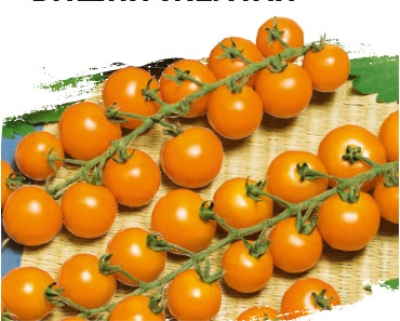
- Authors: S. F. Gavrish, V. V. Morev, E. V. Amcheslavskaya (LLC 'Agrofirma' Gavrish 'and K' LLC breeding company 'Gavrish')
- Year of approval: 1997
- Category: grade
- Growth type: indeterminate
- Appointment: fresh consumption, for whole fruit preservation
- Ripening period: early
- Ripening time, days: 92-96
- Growing conditions: for open ground, for film greenhouses
- Marketability: Yes
- Transportability: Yes
In the 1990s, for obvious reasons, domestic breeding subsided considerably. But still, some developments were underway. And the yellow cherry tomato is just a bright representative of that era.
Breeding history
The preparation of such a plant was carried out jointly by the breeding company "Gavrish" and "Agrofirma Gavrish". The direct work was carried out by a team of breeders in the person of Morev, Amcheslavskaya and S.F. Gavrish. The plant's exploitation permit was issued in 1997.
Description of the variety
Cherry yellow belongs to the indeterminate varieties. This plant is good enough for its commercial characteristics. It can be cultivated both in open ground and in greenhouses. The bushes of Cherry yellow are semi-sprawling, the plant will not have so many branches, and the foliage is moderate. Green leaves are small in size and are slightly corrugated, devoid of stipules.
The main qualities of the fruit
Yellow Cherry berries are not only quite marketable, but also have good transportability. These are decent bright yellow cherry blossoms. The mass of a single berry is 15-20 g. In shape, these fruits are round, and from 20 to 40 tomatoes grow on the cluster. They grow on inflorescences of an intermediate type, on articulated stalks.
Taste characteristics
You can use the harvested crop fresh. It is also suitable for canning whole fruits.
Ripening and fruiting
Yellow cherry ripens relatively early. It usually takes between 92 and 96 days between the emergence of green growth and the removal of tomatoes. Fruiting covers:
July;
August;
September.
Yield
According to this indicator, the variety is not very effective. The collection of berries from 1 plant does not exceed 1-2 kg. However, their high quality largely justifies this problem. It must be remembered that a ripe crop cannot be stored for a long time, and must be sent for processing or quickly eaten.
The timing of planting seedlings and planting in the ground
You need to sow seeds in boxes from March 1 to March 15. If this condition is met, then the seedlings will be ready between May 15 and June 5. With any shift, regardless of the reason (weather excesses, the condition of the plants themselves), the schedule must be adjusted accordingly.

Growing tomato seedlings is an extremely important process, because it largely depends on whether the gardener will be able to harvest at all. All aspects must be taken into account, from seedbed preparation to planting in the ground.
Landing scheme
The usual order is 600x500 mm. When forming a plant, only 1 stem is left. Without following this rule, you cannot count on a good result.

Growing and care
And pinch, and tie, and form such a tomato will have to be sure. It is worth considering the high probability of defeat by cladosporium. The plant is characterized by medium resistance to tobacco mosaic and fusarium wilt. Therefore, it is necessary to take preventive measures and know how to act if infection does occur. Late blight is also dangerous.
An important preventive measure is maintaining optimal density. Excessively thickened bushes are extremely sick. Plants are tied as soon as they reach a height of 35-40 cm. Re-tie and formations usually take place every 7-10 days.




A plant needs different micronutrients at each stage of growth. All fertilizers can be divided into two groups: mineral and organic. Folk remedies are often used: iodine, yeast, bird droppings, eggshells.
It is important to observe the rate and period of feeding. This also applies to folk remedies and organic fertilizers.


Growing regions
Farmers of both the Primorsky Territory and the Moscow Region and the Kurgan Region can easily plant Yellow Cherry without any hesitation. This culture can also give good results in the Astrakhan, Saratov regions, in the Krasnodar and Stavropol regions. In addition to these localities, the variety is zoned into:
Western Siberia;
Eastern Siberia;
Central Black Earth Region.
Review overview
Even those who plant such a tomato for the first time are not disappointed in it. The sweetness of the fruit is highly rated. The bushes are developing quite actively, according to gardeners. It is worth noting the visual beauty of plants, which complements their practical advantages. But there are some complaints about cracking, especially when canning.

























































































